
Omaha, commonly known as Omaha Beach, was the code name for one of the five sectors of the Allied invasion of German-occupied France in the Normandy landings on June 6, 1944, during World War II. "Omaha" refers to an 8-kilometer (5 mi) section of the coast of Normandy, France, facing the English Channel, from east of Sainte-Honorine-des-Pertes to west of Vierville-sur-Mer on the right bank of the Douve River estuary. Landings here were necessary to link the British landings to the east at Gold with the American landing to the west at Utah, thus providing a continuous lodgement on the Normandy coast of the Bay of the Seine. Taking Omaha was to be the responsibility of United States Army troops, with sea transport, mine sweeping, and a naval bombardment force provided predominantly by the United States Navy and Coast Guard, with contributions from the British, Canadian and Free French navies.

United States Army Rangers, according to the US Army's definition, are personnel, past or present, in any unit that has the official designation of "Ranger". The term is commonly used to include graduates of the US Army Ranger School, even if they have never served in a "Ranger" unit.

The 75th Ranger Regiment, also known as Army Rangers, is the U.S. Army's premier light infantry unit and special operations force within the United States Army Special Operations Command. The regiment is headquartered at Fort Benning, Georgia and is composed of a regimental headquarters company, a military intelligence battalion, a special troops battalion, and three Ranger battalions.

La Pointe du Hoc is a promontory with a 35-metre (110 ft) cliff overlooking the English Channel on the northwestern coast of Normandy in the Calvados department, France.

The 29th Infantry Division, also known as the "Blue and Gray Division", is an infantry division of the United States Army based in Fort Belvoir, Virginia. It is currently a formation of the U.S. Army National Guard and contains units from Virginia, Maryland, Kentucky, North Carolina, South Carolina and West Virginia.

The 96th Sustainment Brigade, is a unit of the United States Army that inherited the lineage of the 96th Infantry Division that served in the Asia-Pacific theater during World War II. Effective 17 September 2008, the unit became the 96th Sustainment Brigade, with its headquarters located at Fort Douglas, Salt Lake City, Utah.

The 41st Infantry Division was an infantry division of the United States Army National Guard composed primarily of units from the Pacific Northwest. The division saw active service in World War I and World War II., receiving the nickname Jungleers during the latter.
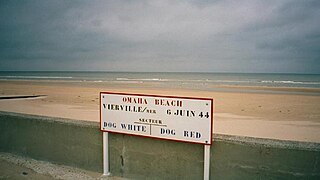
Vierville-sur-Mer is a commune in the Calvados department in Normandy region in northwestern France.
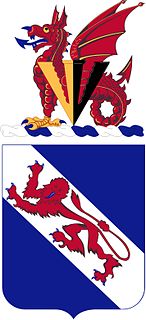
The 508th Infantry Regiment is an airborne infantry regiment of the United States Army, first formed in October 1942 during World War II. The 508th is a parent regiment under the U.S. Army Regimental System, and two battalions from the regiment are currently active: the 1st Battalion, 508th Parachute Infantry Regiment is assigned to the 3rd Brigade Combat Team, 82nd Airborne Division, and the 2nd Battalion, 508th Parachute Infantry Regiment is assigned to the 2nd Brigade Combat Team, 82nd Airborne Division. The regiment served in combat during World War II, and regimental elements have served in combat in the Dominican Republic, Vietnam, Grenada, Panama, Iraq and Afghanistan.

The 2nd Ranger Battalion, currently based at Joint Base Lewis–McChord south of Seattle, Washington, United States, is the second of three ranger battalions belonging to the United States Army's 75th Ranger Regiment.

Grenadier Regiment 916 was an infantry regiment of the Wehrmacht from 1943 until 1945.

The 504th Infantry Regiment, originally the 504th Parachute Infantry Regiment, is an airborne forces regiment of the United States Army, part of the 82nd Airborne Division, with a long and distinguished history. The regiment was first formed in mid-1942 during World War II as part of the 82nd Airborne Division and saw service in Sicily, Italy, Anzio, the Netherlands, Belgium and Germany.

The 327th Infantry Regiment is an infantry regiment of the 101st Airborne Division of the United States Army. During World War II, the 327th was a glider-borne regiment of the 101st Airborne Division. It fought during World War I as part of the 82nd Division. It has also been deployed in the Vietnam War, Gulf War, and most recently to Iraq and Afghanistan. The song "Glider Rider" describes (humorously) some of the slights that glider-borne troops felt they received from the Army during World War II; though the regiment's public fame rose with the 1949 movie Battleground about the Siege of Bastogne in late 1944.
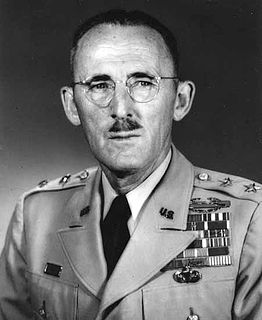
Major General Charles Draper William Canham was the commander of the 29th Infantry Division's 116th Infantry Regiment, which landed on Omaha Beach in Normandy, France on D-Day, June 6, 1944.
The 111th Field Artillery is currently constituted as a composite battalion consisting of two batteries of 105MM towed artillery and one battery of 155MM towed artillery (M777) unit with a general support/reinforcing mission. It is a unit within the Virginia Army National Guard based in Norfolk, Virginia.
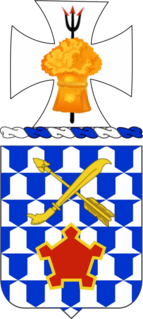
The 16th Infantry Regiment is a regiment in the United States Army and has traditionally been a part of the 1st Infantry Division.

Mission Albany was a parachute combat assault at night by the U.S. 101st Airborne Division on June 6, 1944, part of the American airborne landings in Normandy during World War II. It was the opening step of Operation Neptune, the assault portion of the Allied invasion of Normandy, Operation Overlord. 6,928 paratroopers made their jumps from 443 C-47 Skytrain troop carrier planes into an intended objective area of roughly 15 square miles (39 km2) located in the southeast corner of the Cotentin Peninsula of France five hours ahead of the D-Day landings. The landings were badly scattered by bad weather and German ground fire over an area twice as large, with four sticks dropped as far as 20 miles (32 km) away.
The Provisional Ranger Group was a provisional regiment of U.S. Army Rangers that was formed for the D-Day landings in Normandy, France, in World War II.

The 116th Infantry Regiment is an infantry regiment in the Virginia Army National Guard.
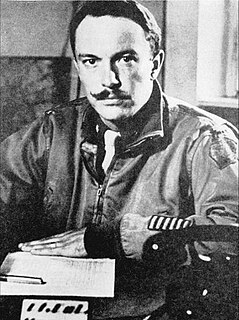
Charles Thompson Horner Jr. was a highly decorated officer of the United States Army who served in the 16th Infantry Regiment, U.S. 1st Infantry Division from July 1940 to February 1946 and held every position from Platoon Leader to Regimental Commander. As a leader in the "Big Red One", he participated in the North Africa, Sicily, and the European Campaigns and three amphibious landings; the invasions of North Africa, Sicily, and Europe where he commanded the 3rd Battalion, 16th Infantry on Omaha Beach.



















